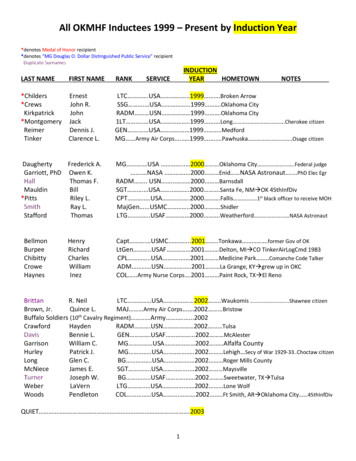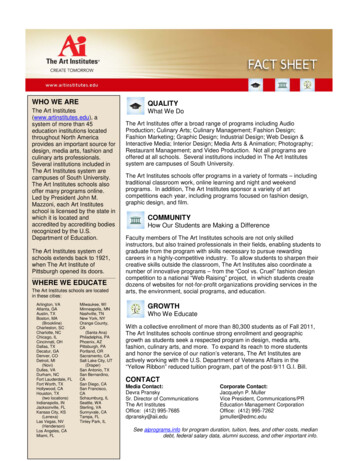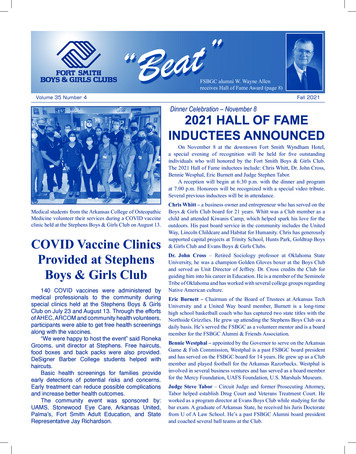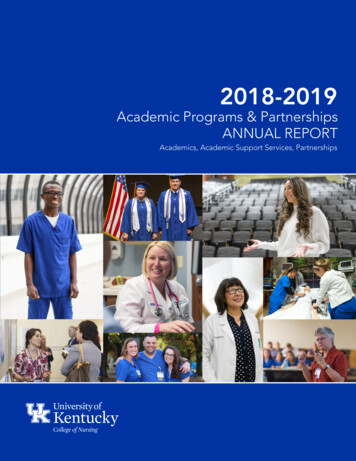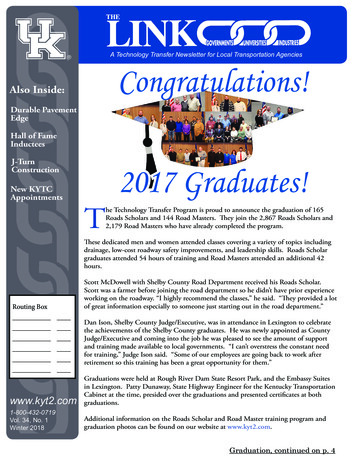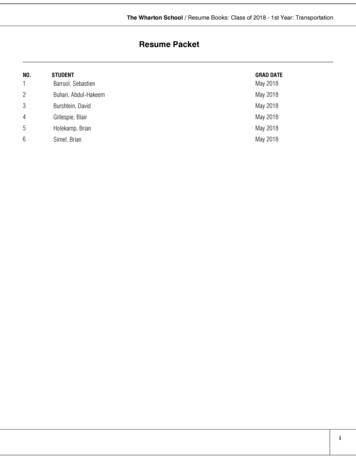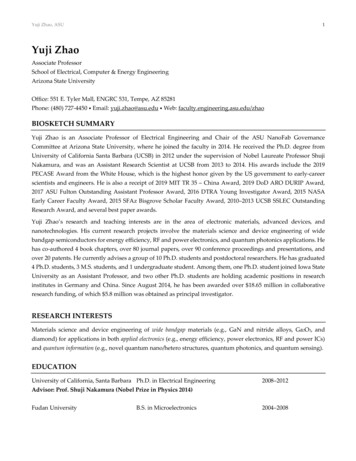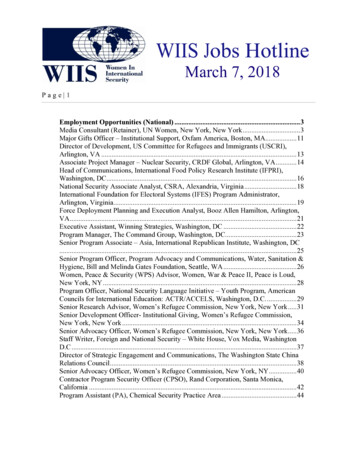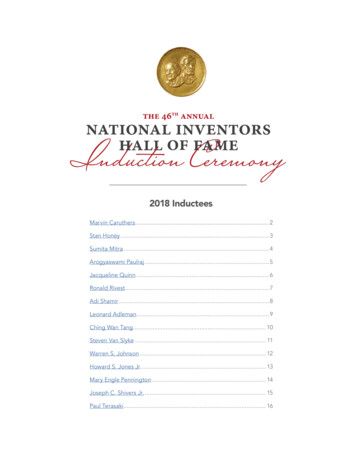
Transcription
2018 InducteesMarvin Caruthers.2Stan Honey.3Sumita Mitra.4Arogyaswami Paulraj.5Jacqueline Quinn.6Ronald Rivest.7Adi Shamir.8Leonard Adleman.9Ching Wan Tang. 10Steven Van Slyke. 11Warren S. Johnson. 12Howard S. Jones Jr. 13Mary Engle Pennington. 14Joseph C. Shivers Jr. 15Paul Terasaki. 16
10 Things You Need to Know AboutMarvin Caruthers2 0 18 N AT I O N A L I N V E N T O R SHALL OF FA ME IN DUC TEEMarvin CaruthersInventor of Chemical Synthesis of DNAU . S . PAT E N T N O S . 4 , 415 , 7 3 2 & 4 , 4 5 8 , 0 6 61.BORN FEBRUARY 11, 1940Marvin Caruthers helped jump-startthe biotechnology industry. With histeam at the University of ColoradoBoulder, Caruthers developed themethods for chemically synthesizingDNA —transforming protein and DNAsynthesis from highly specialized basicresearch into a widely used research,diagnostic and forensic tool.The ability to synthesize DNA — rapidlyand in the laboratory — enablesresearchers to learn how certaingenetic sequences are formed, and tolocate and isolate genes for selectedproteins. Early clinical studies on drugsstemming from Caruthers’ techniquesshowed remarkable benefits forpatients with severe kidney diseaseand cancer.His procedures have been incorporatedinto “gene machines” automatingsynthetic DNA production used bybiochemists, biologists, molecularbiologists and biophysical chemists.More recently, his procedures havebeen adapted for use with modifiedinkjet printers to synthesize DNA onglass chips.Caruthers’ invention is widely considered to be one of thecornerstone technologies behind the biotechnology revolution.2. Since 1973, he has been a distinguished professor of chemistry andbiochemistry at the University of Colorado-Boulder.3. Notable results from his work include the development andcommercialization of pharmaceutical drugs Epogen and Neupogen.4.He was the co-founder of several successful biotech companiesincluding Amgen, Applied Biosystems, Array BioPharma and miRagenTherapeutics.5. He considers himself to be equally a researcher, inventor andentrepreneur.6.In 2007, Caruthers donated 20 million to the University of ColoradoBoulder to construct a new biotechnology center on campus. Thecenter is named for his late wife, Jennie Smoly Caruthers.7.He says his “comfortable but intense” childhood working on a farmshaped his work ethic.8. He believes the biotechnology revolution would not have beenpossible without intellectual property protection.9.He was awarded the 2006 U.S. National Medal of Science.10. He holds 43 U.S. patents.To learn more about the 2018 Class of Inductees, visit www.invent.org/honor/inductees/.Caruthers’ innovation will becelebrated this May as he is Inductedinto the 2018 Class of the NationalInventors Hall of Fame. 2018 National Inventors Hall of Fame, Inc.
10 Things You Need to Know AboutStan Honey2 0 18 N AT I O N A L I N V E N T O R SHALL OF FA ME IN DUC TEEStan HoneyBORN APRIL 8, 1955A pioneer in the field of sports televisiongraphics, Stan Honey has transformedhow we all watch sports. Innovationsdeveloped by Honey and his team atSportvision include the Virtual Yellow 1st& Ten line, introduced on Sept. 27, 1998,during an ESPN-televised game betweenthe Baltimore Ravens and the CincinnatiBengals. Now ubiquitous in football,the superimposed yellow line has beenhailed as one of the most importantdevelopments in sports broadcast history.Other televised sports advances ledby Honey include K-Zone , a baseballpitch tracking and highlighting system;RACEf/x , which tracks NASCAR racersusing GPS; and LiveLine , a helicoptermounted, GPS-tracked camera systemfirst implemented during the 2013America’s Cup in conjunction with GPStracking on the race boats and marks.A professional yachtsman andnavigator, Honey was the 2010Yachtsman of the Year, and is a 2012inductee of the National Sailing Hallof Fame. As navigator, Honey has setrecords for transatlantic, transpacific,circumnavigation, and 24-hour passagesunder sail.Inventor of Football’s Yellow ‘First-and-Ten Line’U . S . PAT E N T N O . 6 ,141, 0 6 01.Stan Honey is a native of San Marino, Calif.2.Honey earned his B.S. in engineering and applied science at YaleUniversity, and his MSEE at Stanford University.3. His television technology inventions combine two lifelong interests:electronics and navigation.4.He has received numerous awards, including three Emmys for technicaland engineering innovations in sports television broadcasts.5. He co-founded Etak Inc., a company that pioneered automobilenavigation systems and digital mapping.6. He co-founded Sportvision in 1998.7.Honey is a 2017 inductee of the Sports Broadcasting Hall of Fame.8. He was the sailing and navigation coach for the 2008 movie “MorningLight.”9.His approach to engineering is “figure it out.”10. He holds 31 U.S. patents in television graphics and in navigationtechnology and tracking.To learn more about the 2018 Class of Inductees, visit www.invent.org/honor/inductees/.Honey’s innovation will be celebrated thisMay as he is Inducted into the 2018 Classof the National Inventors Hall of Fame. 2018 National Inventors Hall of Fame, Inc.
10 Things You Need to Know AboutSumita Mitra2 0 18 N AT I O N A L I N V E N T O R SHALL OF FA ME IN DUC TEESumita MitraInventor of Nanocomposite Dental MaterialsU . S . P A T E N T N O S . 6 , 3 8 7, 9 8 1 , 6 , 5 7 2 , 6 9 3 & 6 , 7 3 0 , 1 5 61.She retired after more than 30 years with 3M, and now runs MitraChemical Consulting LLC with her husband.2.Mitra earned her B.S. in chemistry from India’s Presidency College, herM.S. in organic chemistry from India’s University of Calcutta, and herPh.D. in organic/polymer chemistry from the University of Michigan.BORN FEBRUARY 27, 1949Sumita Mitra’s dental innovationscapture the importance of strengthand the elegance of beauty, allowingher to solve ongoing issues plaguingboth dental patients and professionals.By revolutionizing the field ofdentistry with her invention of thefirst nanocomposite dental materials,she made the development andcommercialization of many dentalproducts possible.Mitra’s invention of Filtek SupremeUniversal Restorative improvedupon previous dental composites byproviding superior optical propertiesboth initially and long-term, whileexhibiting excellent mechanicalstrength and wear resistance. TheFiltek Supreme product line hasbeen used in more than 600 milliondental restorations worldwide since theproduct launched in 2002.Mitra’s innovation will be celebratedthis May as she is Inducted into the2018 Class of the National InventorsHall of Fame.3. Mitra was born in India, going to school in Kolkata until she moved tothe United States.4.She was corporate scientist of the new materials/products researchand development efforts at 3M’s Dental Products Division from 19982010.5. Mitra is a former science coach for the American Chemical Society,where she volunteered to share her chemistry knowledge in Minnesotacommunities.6. Mitra also served as the industrial director of the Minnesota DentalResearch Center for Biomaterials and Biomechanics at the University ofMinnesota’s School of Dentistry.7.She is the winner of many honors and awards, including theInternational Association for Dental Research Peyton-Skinner Awardfor Innovation in Dental Materials (2012); American Chemical Society(ACS) Hero of Chemistry (2009); and the ACS Regional IndustrialInnovation Award (2004).8. She is an experienced lecturer, giving more than 100 presentationsand teaching courses at various universities in 45 countries.9.Mitra has more than 90 publications in the areas of polymer scienceand dental materials.10. She holds 98 U.S. patents and their international equivalents.To learn more about the 2018 Class of Inductees, visit www.invent.org/honor/inductees/. 2018 National Inventors Hall of Fame, Inc.
10 Things You Need to Know AboutArogyaswami Paulraj2 0 18 N AT I O N A L I N V E N T O R SHALL OF FA ME IN DUC TEEArogyaswami PaulrajBORN APRIL 14, 1944If it wasn’t for Arogyaswami Paulraj,you would be living in a much slowerworld. Paulraj pioneered MIMO —Multiple Input, Multiple Output— a wireless technology that hasrevolutionized broadband wirelessInternet access for billions of peopleworldwide. MIMO improves bothtransmission data rates and expandsnetwork coverage. It is the essentialfoundation for all current (WiFi and 4Gmobile) and future broadband wirelesscommunications.Paulraj’s MIMO concept requiresmultiple antennas at both thetransmission and reception stations,unlike prior radio technologies.These multiple antennas, along withappropriate transmitter coding andreceiver decoding, enable multipleparallel data streams to be deliveredover a single radio channel to boostspeed. Beamforming, using themultiple antennas at both ends,improves coverage.Inventor of MIMO Wireless TechnologyU . S . PAT E N T N O. 5 , 3 4 5 , 5 9 91.Paulraj is a native of India.2.His MIMO wireless technology is currently used in all 4G and WiFiservices.3. He served for three decades in the Indian Navy.4.While a researcher in the Indian Navy, he headed one of the country’smost successful military research and development projects — APSOHsonar.5. He founded three national laboratories in India.6. He is a fellow of eight national engineering/science academies in theUnited States, India, China and Sweden.7.He founded Rasa Networks and Iospan Wireless, and co-foundedBeceem Communications. He jokes that “Every time I learn somethingnew, I start a company.”8. He currently is professor emeritus at Stanford University.9.Paulraj has received numerous awards including the 2014 MarconiPrize, and the Institute of Electrical and Electronics Engineers (IEEE)Alexander Graham Bell Medal.10. He holds 79 patents.To learn more about the 2018 Class of Inductees, visit www.invent.org/honor/inductees/.After three decades of service inthe Indian Navy, Paulraj moved tothe United States to join the facultyat Stanford University. Shortly afterjoining Stanford, while working onwireless experiments, he noticedsurprising results in signal separabilitythat became the genesis of MIMO.Paulraj’s innovation will be celebratedthis May as he is Inducted into the2018 Class of the National InventorsHall of Fame. 2018 National Inventors Hall of Fame, Inc.
10 Things You Need to Know AboutJacqueline Quinn2 0 18 N AT I O N A L I N V E N T O R SHALL OF FA ME IN DUC TEEJacqueline QuinnInventor of Emulsified Zero-Valent Iron (EZVI)U . S . PAT E N T N O. 6 , 6 6 4 , 2 9 81.BORN JULY 19, 1967Jacqueline Quinn got into the sciences asa career to nurture the environment. Andas an environmental engineer at NASA,she did just that.An environmentally safe clean-uptechnology called emulsified zerovalent iron (EZVI) was co-invented byQuinn and a team of researchers fromthe University of Central Florida in thelate 1990s. The team developed EZVIto combat contaminants left over fromspace exploration’s early years, whenNASA used chlorinated solvents asdegreasers for rocket engine parts.Heavier than water, these solvents sinkinto the ground and can pollute freshwater sources if left untreated.EZVI works by placing nanoscale zerovalent iron particles into a biodegradablewater-in-oil emulsion. This emulsion isinjected into contaminated groundwaterwhere the system acts like a sponge,pulling the contaminant into theemulsion. Then, reacting with the zerovalent iron, the contaminant breaks downinto harmless byproducts.Quinn calls her EZVI emulsion a “salad dressing” due to its water-in-oilcomposition.2. The EZVI technology was inducted into the Space Technology Hall ofFame in 2007.3. Quinn is currently working on NASA’s Resource Prospector mission,which will search for water under the surface of the Moon.4.She previously worked in NASA’s Space Shuttle Program, working onenvironmental controls on the shuttles Columbia and Atlantis.5. In today’s society, Quinn sees a “gender influence” where girls aren’tnurtured or encouraged to get into science.6. One of her favorite phrases is “I wonder,” because of all the good thatcomes from checking out ideas based on that statement.7.She likes to have brainstorming sessions with her teams outside of theoffice environment, which she calls “ideas on a napkin.”8. Quinn is a great lover of the outdoors. She enjoys hiking, camping,skiing and scuba diving.9.She loves Venn Diagrams, where “different parts come together tofind the right answer.”10. She holds 11 U.S. patents.To learn more about the 2018 Class of Inductees, visit www.invent.org/honor/inductees/.The EZVI system eliminates the needto dig up contaminated water and soil,requires less treatment time, producesless toxic and more biodegradablebyproducts, and is cost-competitive.Now licensed for commercial use, EZVIhas decontaminated groundwatersupplies on government sites; nearplants that manufacture dyes, chemicals,pharmaceuticals, adhesives, aerosolsand paint; and in dry cleaning, leathertanning, and metal cleaning anddegreasing facilities.Quinn’s innovation will be celebrated thisMay as she is Inducted into the 2018 Classof the National Inventors Hall of Fame. 2018 National Inventors Hall of Fame, Inc.
10 Things You Need to Know AboutRonald Rivest2 0 18 N AT I O N A L I N V E N T O R SHALL OF FA ME IN DUC TEERonald RivestBORN MAY 6, 1947Imagine a world without securee-commerce. If you can’t, you haveRonald Rivest to thank! Without thework of Rivest and his colleagueson RSA Cryptography, our personaland financial information would be atmuch greater risk.RSA Cryptography is the world’s mostwidely used public-key cryptographymethod for securing communicationon the Internet. Instrumental in thegrowth of e-commerce, RSA is used inalmost all Internet-based transactionsto safeguard sensitive data such ascredit card numbers.Introduced in 1977 by MIT colleaguesRon Rivest, Adi Shamir and LeonardAdleman, RSA — its name derivedfrom the initials of their surnames— is a specific type of public-keycryptography that enables securemessage encoding and decodingbetween communicating parties.Unlike previous methods requiringsecurely exchanged keys to encryptand decrypt messages, RSAprovided a method for encryptionand decryption without both partiesneeding a shared secret key. RSAcould also mark messages with adigital signature.Inventor of RSA CryptographyU . S . PAT E N T N O. 4 , 4 0 5 , 8 2 91.Rivest grew up in Niskayuna, N.Y., a suburb of Schenectady.2.He was a co-founder of RSA Data Security and VeriSign.3. Following graduate school he accepted a postdoctoral position atINRIA (the French Institute for Research in Computer Science andAutomation).4.He has been a computer science and electrical engineering professorat the Massachusetts Institute of Technology since 1974.5. Rivest’s most famous work is his contribution to the RSA algorithm.6. His research interests include cryptography, computer and networksecurity, electronic voting and algorithms.7.His co-written textbook Introduction to Algorithms has become aclassroom standard.8. He is a Fellow of the Association for Computing Machinery and theAmerican Academy of Arts and Sciences.9.He created a voting mechanism called the ThreeBallot — a papersystem that allows voters to verify that their votes are properlyrecorded and produces an end-to-end audit trail.10. He has received numerous professional honors, including the 2002A.M. Turing Award from the Association for Computing Machinery.To learn more about the 2018 Class of Inductees, visit www.invent.org/honor/inductees/.Rivest’s innovation will be celebratedthis May as he is Inducted into the2018 Class of the National InventorsHall of Fame. 2018 National Inventors Hall of Fame, Inc.
10 Things You Need to Know AboutAdi Shamir2 0 18 N AT I O N A L I N V E N T O R SHALL OF FA ME IN DUC TEEAdi ShamirBORN JULY 6, 1952Imagine a world without securee-commerce. If you can’t, you haveAdi Shamir to thank! Without thework of Shamir and his colleagueson RSA Cryptography, our personaland financial information would be atmuch greater risk.RSA Cryptography is the world’s mostwidely used public-key cryptographymethod for securing communicationon the Internet. Instrumental in thegrowth of e-commerce, RSA is used inalmost all Internet-based transactionsto safeguard sensitive data such ascredit card numbers.Introduced in 1977 by MIT colleaguesRon Rivest, Adi Shamir and LeonardAdleman, RSA — its name derivedfrom the initials of their surnames— is a specific type of public-keycryptography that enables securemessage encoding and decodingbetween communicating parties.Inventor of RSA CryptographyU . S . PAT E N T N O. 4 , 4 0 5 , 8 2 91.Shamir is a native of Tel Aviv, Israel.2. Shamir’s most famous work is his contribution to the RSA algorithm.3. He was a co-founder of RSA Data Security.4.He is an expert in cryptographic schemes and protocols, and has aspecialization in cryptanalysis.5. Shamir is a frequent panelist and speaker at international cryptographyconferences.6. He has advanced the field of identity-based cryptography.7.Since 1980, he has been a professor of computer science and appliedmathematics at Israel’s Weizmann Institute of Science.8. Shamir thinks artificial intelligence can be used to better understandinteractions and behaviors.9.He was awarded the 2002 A.M. Turing Award from the Association forComputing Machinery.10. He was among three winners of the 2017 Japan Prize, an awardhonoring achievement in science and technology.To learn more about the 2018 Class of Inductees, visit www.invent.org/honor/inductees/.Unlike previous methods requiringsecurely exchanged keys to encryptand decrypt messages, RSAprovided a method for encryptionand decryption without both partiesneeding a shared secret key. RSAcould also mark messages with adigital signature.Shamir’s innovation will be celebratedthis May as he is Inducted into the2018 Class of the National InventorsHall of Fame. 2018 National Inventors Hall of Fame, Inc.
10 Things You Need to Know AboutLeonard Adleman2 0 18 N AT I O N A L I N V E N T O R SHALL OF FA ME IN DUC TEELeonard AdlemanInventor of RSA CryptographyU . S . PAT E N T N O. 4 , 4 0 5 , 8 2 91.Adleman’s research interests include algorithms, computationalcomplexity, computer viruses, cryptography, DNA computing,immunology, molecular biology, number theory and quantumcomputing.2.He is considered the “Father of DNA Computing,” or computing thatuses biochemistry and molecular biology.BORN DECEMBER 31, 1945Imagine a world without securee-commerce. If you can’t, youhave Leonard Adleman to thank!Without the work of Adleman and hiscolleagues on RSA Cryptography, ourpersonal and financial informationwould be at much greater risk.RSA Cryptography is the world’s mostwidely used public-key cryptographymethod for securing communicationon the Internet. Instrumental in thegrowth of e-commerce, RSA is used inalmost all Internet-based transactionsto safeguard sensitive data such ascredit card numbers.Introduced in 1977 by MIT colleaguesRon Rivest, Adi Shamir and LeonardAdleman, RSA — its name derivedfrom the initials of their surnames— is a specific type of public-keycryptography that enables securemessage encoding and decodingbetween communicating parties.Unlike previous methods requiringsecurely exchanged keys to encryptand decrypt messages, RSAprovided a method for encryptionand decryption without both partiesneeding a shared secret key. RSAcould also mark messages with adigital signature.3. He is a Distinguished Professor of Computer Science and holder of theHenry Salvatori Chair in Computer Science.4. As a child, he was inspired by the children’s television program “Mr.Wizard.”5. Adleman is an avid boxer who has trained alongside severalprofessional world champions.6. He was the “mathematical consultant” for the 1992 movie “Sneakers.”7.Adleman is quoted as saying, “Becoming a mathematician is like fallingin love.”8. He is a dynamic speaker.9.He has received numerous professional honors, including the 2002A.M. Turing Award from the Association for Computing Machinery.10. He currently dedicates himself to research in complex analysis, abranch of mathematical analysis that investigates functions of complexnumbers.To learn more about the 2018 Class of Inductees, visit www.invent.org/honor/inductees/.Adleman’s innovation will becelebrated this May as he is Inductedinto the 2018 Class of the NationalInventors Hall of Fame. 2018 National Inventors Hall of Fame, Inc.
10 Things You Need to Know AboutChing Wan Tang2 0 18 N AT I O N A L I N V E N T O R SHALL OF FA ME IN DUC TEEChing Wan TangBORN JULY 23, 1947The reach of OLED — organic lightemitting diode — is found in your hand,on your wall and on shelves in consumerelectronics stores worldwide.Chemists Ching Wan Tang and StevenVan Slyke pioneered OLED — an advancein flat-panel displays found in computers,cell phones and televisions that providesincreased power efficiency, longer batterylife and improved display quality.OLEDs can be used wherever LCDs areused. They are thinner, lighter, providesuperior brightness and color, and offerultra-fast response time for functions suchas refreshing and on-off switching. UnlikeLCDs that rely on a backlight that passesthrough color filters to produce light,OLED screens utilize luminescent organicmaterials to make their own light.The first OLED product was a displayfor a car stereo, commercialized byPioneer in 1997. Kodak’s EasyShare LS633digital camera, introduced in 2003, wasthe first consumer electronic productincorporating a full-color OLED display.Today, Samsung uses OLEDs in all itssmartphones, and LG manufactureslarge OLED screens for premium TVs.Other companies incorporating OLEDtechnology include Apple, Google,Facebook, Motorola, Sony, HewlettPackard, Panasonic, Konica, Lenovo,Huawei, BOE, Philips and Osram. TheOLED display market is expected to growto 57 billion by 2026.Inventor of Organic Light-Emitting Diode (OLED)U . S . PAT E N T N O. 4 , 3 5 6 , 4 2 91.Tang is a native of Hong Kong.2.His research interests include chemical and condensed matterphysics and organic electronics.3. He invented the first heterojunction organic solar cell.4.He is currently on the faculty at the Hong Kong University of Scienceand Technology, and he is professor emeritus at the University ofRochester.5. Tang was a distinguished research fellow at Eastman Kodak from1975-2006.6. He received his B.S. in chemistry from the University of BritishColumbia, and his Ph.D. in physical chemistry from Cornell University.7.Tang is a founding member of the Academy of Sciences of HongKong.8. He is a 2013 Inductee of the Consumer Technology Association’sConsumer Technology Hall of Fame.9. Tang has received numerous awards for his work on organic materialsand electronics, including the 2011 Wolf Prize in Chemistry and the2004 American Chemical Society Award for Team Innovation sharedwith Steven Van Slyke.10. He has been named on 84 patents.To learn more about the 2018 Class of Inductees, visit www.invent.org/honor/inductees/.Tang’s innovation will be celebrated thisMay as he is Inducted into the 2018 Classof the National Inventors Hall of Fame. 2018 National Inventors Hall of Fame, Inc.
10 Things You Need to Know AboutSteven Van Slyke2 0 18 N AT I O N A L I N V E N T O R SHALL OF FA ME IN DUC TEESteven Van SlykeInventor of Organic Light-Emitting Diode (OLED)U . S PAT E N T N O . 4 , 5 3 9, 5 0 71.BORN JULY 19, 1956The reach of OLED — organic lightemitting diode — is found in your hand,on your wall and on shelves in consumerelectronics stores worldwide.Chemists Steven Van Slyke and ChingWan Tang pioneered OLED — an advancein flat-panel displays found in computers,cell phones and televisions that providesincreased power efficiency, longer batterylife and improved display quality.OLEDs can be used wherever LCDs areused. They are thinner, lighter, providesuperior brightness and color, and offerultra-fast response time for functions suchas refreshing and on-off switching. UnlikeLCDs that rely on a backlight that passesthrough color filters to produce light,OLED screens utilize luminescent organicmaterials to make their own light.The first OLED product was a displayfor a car stereo, commercialized byPioneer in 1997. Kodak’s EasyShare LS633digital camera, introduced in 2003, wasthe first consumer electronic productincorporating a full-color OLED display.Today, Samsung uses OLEDs in all itssmartphones, and LG manufactureslarge OLED screens for premium TVs.Other companies incorporating OLEDtechnology include Apple, Google,Facebook, Motorola, Sony, HewlettPackard, Panasonic, Konica, Lenovo,Huawei, BOE, Philips and Osram. TheOLED display market is expected to growto 57 billion by 2026.He worked at Eastman Kodak from 1979-2010, serving as researchfellow and director of OLED Solid State Lighting.2. Van Slyke is chief technology officer at Kateeva, which is pioneeringinkjet printing technology enabling high-volume manufacturing offlexible and large-size OLED displays.3. Van Slyke played lacrosse in high school.4.He earned a B.S. in chemistry from Ithaca College, and an M.S. inmaterials science from the Rochester Institute of Technology.5. In college, Van Slyke gained an interest in electrical engineering,which would figure prominently in his later OLED work.6. He is an avid bicycle rider.7.He is a 2013 Inductee of the Consumer Technology Association’sConsumer Technology Hall of Fame.8. He has received numerous awards, including the 2004 AmericanChemical Society Award for Team Innovation shared with Ching WanTang.9.Van Slyke has published more than 40 papers on OLED.10. He holds 40 U.S. patents.To learn more about the 2018 Class of Inductees, visit www.invent.org/honor/inductees/.Van Slyke’s innovation will becelebrated this May as he is Inductedinto the 2018 Class of the NationalInventors Hall of Fame. 2018 National Inventors Hall of Fame, Inc.
10 Things You Need to Know AboutWarren S. Johnson2 0 18 N AT I O N A L I N V E N T O R SHALL OF FA ME IN DUC TEEWarren S. JohnsonInventor of Temperature ControlU . S . PAT E N T N O S . 2 81, 8 8 4 & 5 4 2 , 7 3 31.NOV. 6, 1847 - DEC. 5, 1911Wisconsin’s harsh winter temperaturesspurred Warren Johnson’s inventionof the electric room thermostat. Andthe company he co-founded, JohnsonControls, led the growth of the now multibillion-dollar building controls industry.In 1876, Johnson began teaching atWhitewater Normal School, whereclassrooms were heated by basementhot-air furnaces. The system yieldedfluctuating classroom temperatures;hand-operated dampers located atthe basement furnaces were the sole,inefficient means of adjustment. Eachhour, a custodian entered classroomsto assess temperature, then opened orclosed dampers as needed. The ongoingdisruption spurred Johnson to developa practical solution, leading to his 1883patent for the bi-metallic thermostat. Thiseliminated hourly interruptions, but stillrequired manual intervention. Johnsonimproved the electric room thermostatby incorporating compressed air withelectricity, which automated operation ofthe valves and dampers. In 1885, Johnsonleft teaching to concentrate fully onadvancing his technology.In 1895, Johnson introduced the firstmulti-zone automatic temperaturecontrol system commercially feasiblefor widespread application. In 2008, itwas designated an American Society ofMechanical Engineers Historic MechanicalEngineering Landmark.Warren Johnson was born in 1847 in Leicester, Vt., tohomesteading farmers.2. As a boy, he kept a book of sketches of mechanical, chemicaland electrical inventions.3.Despite his lack of formal education, he became a surveyor,teacher, superintendent of schools and college professor.4. Teaching colleagues at the State Normal School in Whitewater,Wis. now the University of Wisconsin-Whitewater, consideredJohnson “one of the most strikingly original teachers.”5. In his private laboratory, he conducted experiments in areasincluding electro-chemistry — a glamour science of the day.6. He co-founded the Johnson Electric Service Company (nowJohnson Controls) in Milwaukee, Wis.7.The Johnson System of Temperature Regulation was usedin commercial buildings, offices and schools, and it also wasinstalled in the U.S. Capitol, the Smithsonian Institution, theNew York Stock Exchange, and the home of industrialistAndrew Carnegie.8. Johnson also created and commercialized early steampowered motor vehicles, experimented with wirelesscommunications and designed large pneumatic clock towers.9.Johnson was recognized by the American Society ofMechanical Engineers with a Historic Mechanical EngineeringLandmark in 2008.10. He held more than 30 U.S. patents.To learn more about the 2018 Class of Inductees, visit www.invent.org/honor/inductees/.Johnson’s innovation will be celebrated thisMay as he is Inducted into t
4. He has received numerous awards, including three Emmys for technical and engineering innovations in sports television broadcasts. 5. He co-founded Etak Inc., a company that pioneered automobile navigation systems and digital mapping. 6. He co-founded Sportvision in 1998. 7. Honey is a 2017 inductee of the Sports Broadcasting Hall of Fame. 8.

